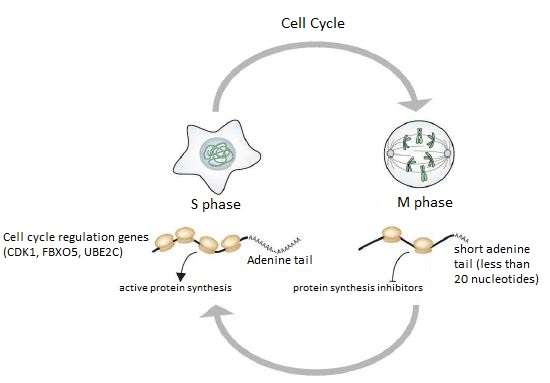New research shows that poly(A) tail length regulates translation of somatic cell cycle

Before mRNA can be used by ribosomes as a guide to build proteins, it has to undergo a series of processing steps. This includes getting a series of adenine (A) nucleotides added by poly(A) polymerase to one of the mRNA's ends. This addition of multiple (A) nucleotides results in a poly(A) tail. After this process is completed, the mRNA can continue on its way to be exported out of the nucleus where it will be used for translation.
Until now, it was thought that the length of these poly(A) tails were critical for mRNA stability and translation, but their actual correlation were unknown. Researchers working at the IBS Center for RNA Research have shown that translation efficiency and poly (A) tail length are not linearly correlated and only coupled in limited range. This challenges the established view of mRNA translation and offers new insight into the somatic cell cycle. To show this, the IBS team used two measuring processes, the first called TAIL-seq, something that they pioneered in 2014 to count nucleotides on the genomic level and also ribosome profiling which reveals translational efficiency. First author Jong-Eun Park said that "By combining these two techniques, I was able to compare poly(A) tail length and translation efficiency and find if there is a correlation between them".
The most recently established theory has been that tail length and efficiency is only coupled in embryonic cells but not in somatic cells since in embryonic cells the cell cycles are synchronized and in somatic cells they are heterogeneous. According to Park, "We synchronized the cell cycles in somatic cells to generate homogeneous data and found that there is a certain length of poly(A) tails that can provide fully efficient translation in somatic cells."

They also found several genes that are deadenylated (they lose some of their adenine) before the M-phase (the phase where the cell divides, called mitosis) and they saw that when the tail length gets shorter than 20 adenines, it represses the translation. Park believes that this repression is important for M-phase progression.
"Finding the exact role of the poly(A) tail is important," says Park, "by doing this research, we are trying to find the regulatory role that the poly(A) tail has." Based on this research, there are two things the team is looking to pursue in the future. First, they now know what kind of genes have regulated poly(A) tails and they want to know how they are regulated. Second, they are trying to assess the importance of this regulation in cell cycle progression.
Interestingly, they found large differences in tail lengths of poly(A) tail regulatory genes like CDK1, TOP2A and FBXO5. These genes have a known function in the cell cycle; they regulate the progression in the M-phase. Park says "For those genes, most studies have been focused on protein level. It will be interesting to study what's so special about their mRNA."
Mis-regulation of cell cycle is hallmark of human cancers. The researchers at the Center for RNA Research are not specifically looking at the relationship of the poly(A) tail cycle on tumorigenesis but Park believes that this research is, "helping to build the foundation for further work which could be applied towards cancer research".
More information: Jong-Eun Park, Hyerim Yi, Yoosik Kim, Hyeshik Chang, and V. Narry Kim; Regulation of Poly(A) Tail and Translation during the Somatic Cell Cycle, Molecular Cell (2016), http:// dx.doi.org/10.1016/j.molcel.2016.04.007
Provided by Institute for Basic Science



















